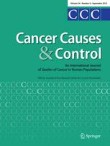
Abstract
Purpose
This study investigated the direct and indirect effects of socioeconomic status (SES) on the survival time of cancer patients by using cancer stage to create a pathway from SES to health outcomes and facilitate a mechanistic inference.
Methods
Both a traditional mediation analysis and a counterfactual event-based mediation analysis were applied to SEER (The Surveillance, Epidemiology, and End Results) data from the National Cancer Institute of the United States. A Cox proportional hazards model for survival analysis was performed in the mediation analysis.
Results
The counterfactual event-based mediation analysis showed that the effect of SES on survival time was partially mediated by stage at diagnosis in lung (12%), liver (14.33%), and colorectal (9%) cancers. Investigation of the fundamental mechanism involved thus established the direct effect of SES on survival time and the indirect effect of SES on survival time through stage at diagnosis. Moreover, the mediation analysis also revealed that the disparity in timely diagnosis (i.e., stage at diagnosis) caused by SES was slightly significant.
Conclusions
SES can either affect cancer survival directly or indirectly through stage at diagnosis. Opportunities to reduce cancer disparity exist in the design of early detection policies or mechanisms for patients with varying resources.
Δεν υπάρχουν σχόλια:
Δημοσίευση σχολίου